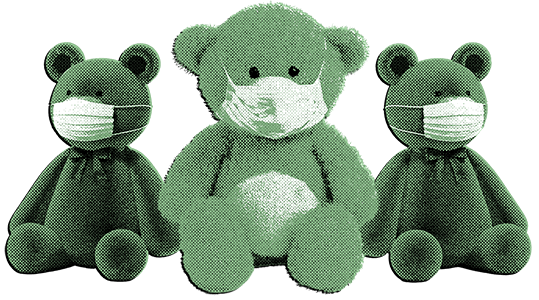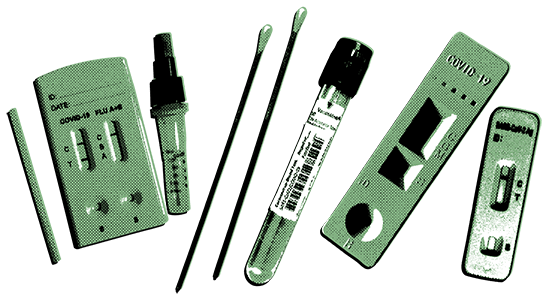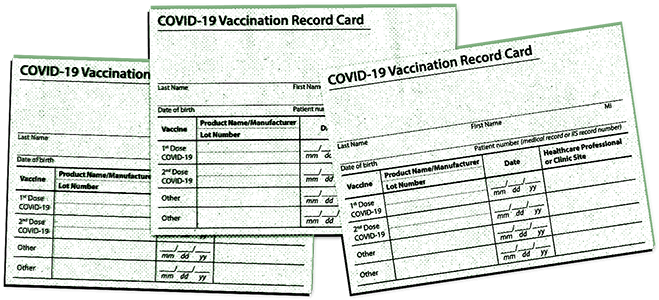If there's one thing we've learned since March 2020, it's that pandemics are all about hard decisions. It's hard to keep track of the information that helps us make those choices — let alone notice or remember when new science and expert recommendations come along. At FiveThirtyEight, we want to help. We’ve read the science and have come up with broad assumptions you can make based on where the evidence is. When the science changes, so will the assumptions: We’ll be updating this page regularly as new research is published.
We think these assumptions will help you more easily make decisions for yourself and your family. (But do let us know if there are risk-assessment questions you think we’re leaving out.) We want this tool to be something that helps take the stress out of decision-making so that you can worry more about the best way to live and less about the virus.

What you can assume
Breakthrough cases — especially symptomatic ones — are rare, even with the reduced effectiveness of vaccines against the delta variant. If you do catch COVID-19 but you are vaccinated, you can spread it but are probably contagious for a shorter period of time — and are probably less likely than an unvaccinated person to spread it.
Why we make this assumption
- Vaccinated people are much less likely to catch COVID-19.
You can’t spread the virus if you don’t contract it. Prior to delta becoming the dominant strain, vaccine efficacy was holding quite steady. Studies of Pfizer trial participants all over the world still found efficacy rates between 86 percent and 100 percent through March 2021, six months after those people had been fully vaccinated. There's evidence, however, that some combination of delta and time has reduced that efficacy. A study of vaccinated health care workers in the United States showed that vaccination was 66 percent effective at preventing both symptomatic and asymptomatic illness during the time when delta was the predominant strain at the study sites. Recent data from the U.K. has also turned up evidence that the Pfizer vaccines’ efficacy had fallen, remaining about 70 percent effective against COVID-19 through August 2021. That’s significantly less effective than the vaccine’s 91 percent rate prior to the spread of the delta variant, but it’s still far, far better at preventing illness (and thus transmission) than no vaccine. (One-dose vaccines — like Johnson & Johnson’s — have displayed lower efficacies.) This data has led health agencies in several countries to approve booster shots, which have been shown to increase protection compared with vaccinations without boosters. However, the scientific community is still debating whether to prioritize booster shots or prioritize getting unvaccinated people vaccinated, given the finite amount of vaccine available. Just 2.9 percent of people in low-income countries had received a first dose of vaccine as of Oct. 21. Getting those people vaccinated is key to reducing both the global spread of COVID-19 and the likelihood of new variants developing. So, the debate comes down to which matters more: making sure people in wealthy countries are as protected as possible or getting everyone somewhat protected. That's an ethical question as much as a scientific one, but it's important to be aware of, even if we don't have the answer.
- Real-world cases show vaccinated people can spread the disease.
- But the evidence doesn’t suggest that vaccinated people are as likely as the unvaccinated to spread COVID-19.
Infected, vaccinated people in Provincetown had high viral loads, but it’s not clear that viral load in the nose is the right way to determine a person’s infectiousness. A Chinese study that hasn’t been peer-reviewed found that vaccination was associated with a 65 percent reduction in transmission among people who had contracted the delta variant. Another study based on data collected in Israel found that 80 percent of the vaccinated people involved in a recent outbreak didn’t spread COVID-19 to anyone else. And even if nasal viral load does turn out to be a good proxy for infectiousness, the CDC has since said that vaccinated people retain those viral loads for shorter periods of time than unvaccinated people — suggesting the vaccinated aren’t contagious as long.

What you can assume
It is possible for the delta variant of COVID-19 to spread outside, even among the vaccinated. That said, outdoor transmission is probably still unlikely if you avoid crowds. If you’re vaccinated and not all up in one another’s business, outdoor transmission shouldn’t be a major fear.
Why we make this assumption
- Pre-delta research suggested risks of outdoor transmission were small.
In November 2020, a systematic review found that less than 10 percent of globally documented outbreaks were associated with outdoor settings. The authors of that study have since clarified that the 10 percent figure was just an estimate — and a high one at that. It was meant to capture the study’s upper limits and keep people from getting too complacent while outdoors. The authors wrote in June that the rate of outdoor transmission is probably much less than 10 percent.
- There’s not much delta-specific research, but evidence suggests it’s still fairly safe to be outside together.
There have definitely been cases of outdoor transmission of the delta variant, including a frequently cited case where six out of the 92 people who attended an outdoor tent wedding near Houston in early April contracted COVID-19. One of those six died. Vaccination was required for attendance at the wedding, but two people who traveled to Houston from India seem to have brought a breakthrough infection with them. Everyone else who got sick had close contact with them. Despite situations like this, outdoor transmission is still a low risk, said Dr. David Wohl, a professor of medicine in the division of infectious diseases at the University of North Carolina School of Medicine. Delta is more contagious because it produces higher levels of the virus in nasal passages and lungs, so there’s more to spread around when a person coughs or sings or talks. And that makes it more likely that someone nearby is going to get a high enough dose to catch the disease themselves. But viruses are still fragile, and being outdoors is still a great way to disperse and kill them. All the stuff that makes the outdoors the outdoors — air circulation, moisture and UV light — are not great for viruses.
- However, all outdoor contact is not the same.

What you can assume
Long COVID is real, and it is possible for anyone to get it. That includes kids and vaccinated people — although both are probably less likely to end up with long COVID than unvaccinated adults. But we don’t really know the rates, largely because there still isn’t any universal definition of what does and doesn’t count as long COVID. Be cautious with assuming anything too precise from very imprecise research.
Why we make this assumption
- Researchers say most studies of long COVID are still frustratingly vague, flawed and hard to compare with one another.
- Long COVID is real.
Just because diagnostic criteria are still confusing and there aren’t solid numbers on prevalence doesn’t mean the syndrome is imaginary. Let’s narrow down the symptom list and focus on fatigue as an example. It’s a symptom that can cause real, life-changing disability and is a known side effect of other viral infections. Studies find that anywhere between 10 percent and 35 percent of former COVID-19 patients are still experiencing significant fatigue that can’t be explained by other illnesses or psychiatric causes six months after their initial infection. Studies have found that long COVID is probably more common in women than in men, in older people than in younger ones, and in people who had more symptoms (though not necessarily more severe symptoms) during their initial infection.
- Preliminary research suggests long COVID is less likely to occur in patients who were previously vaccinated and in patients under age 10.
Vaccination reduces the risk of long COVID by simply reducing the risk of contracting COVID-19 at all, but there is also some recent evidence that breakthrough cases are less likely to develop long-term symptoms. A study of self-reported symptom data from COVID-19 patients in the U.K. found that people who said they were fully vaccinated with two-dose vaccines were about half as likely to still have COVID-19 symptoms 28 days after infection. Likewise, there’s a recent study out of the U.K. that found only 4.4 percent of pediatric COVID-19 patients were still experiencing symptoms after 28 days, and less than 2 percent still had symptoms after 56 days. That study fits with a broader context of research that suggests kids can get long COVID but are less likely to do so than adults. However, again, all of this has to be considered through the reality that long COVID research is messy and one-study-at-a-time is not necessarily a great way to learn anything.

What you can assume
Everyone (kids included) is more likely to catch COVID-19 than they were earlier this summer. The delta variant is more contagious, but it doesn’t seem to be worse for kids than for adults, either in likelihood of transmission or severity of illness. Kids who spend their time around vaccinated adults and teens are at lower risk.
Why we make this assumption
- Real-world data shows cases and hospitalizations among U.S. children rose quickly with delta.
The CDC has tracked this in detail, and it’s striking. As with adults, cases in children have risen and fallen over the course of the pandemic, with a pre-delta weekly peak rate of diagnosed cases happening in January 2021 — 205.9 per 100,000 kids ages 5 to 11. By June, cases among that same age group had dropped to almost nil, just 14.4 cases per 100,000. But the spread of the delta variant caused cases to come roaring back, cresting in late August at 305.7 per 100,000. Hospitalization rates among kids rose by nearly five times between the weeks of June 26 and Aug. 14, as delta spread and schools began to reopen. (Hospitalizations in children peaked the week of Sept. 11 and then began to decline through early October.) At all points, the rates of infection were lower among younger kids and higher among older ones, though rates of hospitalization were highest for babies, toddlers and teens, with 5- to 11-year-olds significantly better off than those groups. The good news is that there’s no evidence that delta is causing more severe illness in children. A study of kids hospitalized for COVID-19 found that the share of patients who ended up in the ICU didn’t change between the pre-delta period and the period after delta became the dominant strain.
- Delta is more contagious than earlier variants.
This is true for everyone, which is why we’re seeing cases increase among kids. It’s not that kids are more susceptible to the delta variant — or at least there’s currently no evidence of that. It’s just that it’s easier for everyone to catch this strain of COVID-19, and kids make up a bigger share of the unvaccinated population than they used to. When a variant is more than twice as contagious, it will spread faster, especially among people not protected by vaccines — even when that demographic had previously not represented a high share of diagnosed cases or seemed to suffer particularly serious disease.
- Vaccinating adults protects kids.
Data from late August shows how severe cases of COVID-19 in children became concentrated in the parts of the country with the lowest rates of adult and teen vaccination. In New England, where more than 72 percent of the eligible population was vaccinated, the daily rate of cases of COVID-19 in people 17 and under was about 13 for every 100,000. In the Southeast, where less than 50 percent of eligible people were vaccinated, the daily childhood COVID-19 rate was nearly 50 per 100,000. Between Aug. 14 and Aug. 27, kids under age 18 were more likely to be admitted to the hospital or ER in regions with lower vaccine coverage than in regions with higher vaccination rates. Vaccination reduces the spread of COVID-19, which helps protect those who can’t be vaccinated yet.

What you can assume
They do. But effectiveness depends on the type of mask you and those around you are wearing.
Why we make this assumption
- There’s been a lot of research on mask effectiveness since the start of the pandemic.
Back in March and April 2020, there was genuine debate among scientists about whether masking was significantly effective at preventing the spread of COVID-19, especially compared with interventions like social distancing. That has not been the case for at least a year. In January 2021, a systematic review of many different types of studies concluded that mask wearing — especially if widely adopted — was effective at reducing COVID-19 transmission. An August 2021 study of nearly 350,000 adults across 600 villages in Bangladesh found that widespread use of surgical masks, even at levels below 50 percent, reduced the likelihood of contracting COVID-19 by 11 percent — 35 percent for people over 60.
- Your cloth mask is not as effective as you probably think it is.
Research has shown that not all types of masks are created equal, especially now that the more transmissible delta variant is predominant. For example, experts have been warning for a while that bandanas and thin fabric neck gaiters aren’t effective at blocking transmission of airborne particles. But additional evidence now shows that even multilayered cloth masks aren’t as effective as well-fitting surgical or N95 masks. One study that hasn’t yet been peer-reviewed found that fabric face masks (which have a lot of variability in design and material) blocked between 62.6 to 87.1 percent of fine particles, while surgical masks blocked an average of 78.2 percent and N95s blocked 99.6 percent. Some countries, including France, have banned DIY cloth masks and stipulated that only certain types of factory-produced varieties are acceptable. Early in the pandemic, cloth masks were promoted as a way to get people masked up when there was a shortage of higher-quality masks, but mask supply has since caught up with the demand in the United States. N95s — and the Chinese- and Korean-made equivalent KN95s and KF94s — are widely available now, and, as of Sept. 10, the CDC says they should not just be reserved for medical staff. Proper fit is a big deal here, though. A poorly fitting surgical mask is not an upgrade from a well-fitting cloth mask.

What you can assume
While instant at-home tests have their place, they won’t necessarily give you the most reliable answers.
Why we make this assumption
- If you’ve been exposed to someone with COVID-19, test sensitivity matters.
Sensitivity is defined as the likelihood that a test will spot a potential infection. High-sensitivity tests are unlikely to produce a false negative — that is, send you out into the world thinking you’re healthy when you actually have COVID-19. Test sensitivity is particularly important for situations where asymptomatic people are exposed to COVID-19, or when someone is on a routine testing schedule to prevent spread in a work or school setting. The tests with the highest sensitivity are molecular (PCR) tests — the sort offered at drive-through clinics and state-run testing centers since early in the pandemic. These rely on specialized laboratory equipment that can find even tiny scraps of viral RNA and then make enough copies of the virus so that its presence is detectable. The tests can take several forms, including the ol’ swab up the nose, a saliva test or a throat swab. If you’re getting the nasal swab version, the highest sensitivity comes from the tests in which trained health care providers put the swab way up in the back of your nasal cavity. Less intrusive ones work but are more likely to produce a false negative.
- Instant at-home tests are less sensitive.
The at-home kits are antigen tests, which are different (and less sensitive) than molecular tests. They're designed to spot relatively large pieces of viral protein — something you're more likely to have if you have a high viral load. Compared with molecular tests, these will turn up a false negative more often, especially in asymptomatic people. In general, at-home tests are probably a better option for situations when you know you’re sick and want to know what you’re sick with. Also, to clarify, there is a rapid molecular test, too, but it’s not administered at home. Its sensitivity is lower than regular molecular tests but higher than the antigen tests.

What you can assume
It’s still best to follow the CDC guidelines, which currently recommend a quarantine for 14 days (from the point of exposure) for unvaccinated people. They also recommend testing at least five days after exposure. Vaccinated people, according to the CDC, can skip quarantine if they show no symptoms, but they should still be tested three to five days after contact and wear a mask indoors in public until they have the results. (The CDC also says there are ways to shorten the quarantine period.)
Why we make this assumption
- Different states and agencies offer different guidelines, but they're all based on the same science as the CDC’s.
Quarantine means staying home and away from other people after recently being in close contact with someone diagnosed with COVID-19 while waiting to see whether you’ve been infected. If you are confused about how long your quarantine should last, that’s probably because different states and organizations have presented different guidelines, and the information isn’t always clear. For example, the New York Department of Health requires a 10-day quarantine for unvaccinated people (unless they have recovered from the virus within the past three months), while their rules for the vaccinated follow the CDC’s. The Minnesota Department of Health doesn’t give an explicit quarantine time length for the unvaccinated, but it does say COVID-19 can take up to 14 days to make you sick and that there’s a possibility of doing a shortened seven-day quarantine. The California Department of Health gives unvaccinated people exposed to COVID options for 14-day, 10-day and seven-day quarantine routines, depending on circumstances. There’s variation even between states that have taken the pandemic seriously — and that’s before you get to county health departments, schools and other entities that might set their own rules.
- Differences and changes don’t mean it’s just all arbitrary.
Most infected people will show symptoms or a positive test result within 14 days of exposure, said Michael Springer, a professor of systems biology at Harvard University. But there’s a reason some quarantine periods aren’t 14 days long. Recommended quarantine timelines are based both on scientific evidence about how long it takes for COVID-19 to make a person sick or contagious, and on attempts to balance that with other kinds of concerns, including economic constraints, child care availability and plain ol' not wanting to be trapped in the house that long. The deviations from CDC guidelines don’t mean experts can’t agree on the science, Springer told us. Instead, the deviations demonstrate that different communities are trying to balance the competing needs of science and society in a variety of ways. A long quarantine that ends up ignored could lead to more transmission than a shorter quarantine that allows some cases to slip through but has a higher compliance rate. Changing science and circumstances are also factors. Most recently, CDC guidelines changed to give vaccinated people an easier, quarantine-free path because research shows they're less likely to catch and transmit COVID-19. And you should expect recommended quarantine lengths to change in the future, Springer said. If a new variant turns up and has high rates of vaccine breakthrough or takes longer to develop symptoms, that'll change the calculus. On the flip side, if vaccination rates get high enough, quarantine recommendations could disappear altogether.
"make" - Google News
October 25, 2021 at 09:00PM
https://ift.tt/3pCjjmu
The Science You Need To Make Your COVID-19 Decisions - FiveThirtyEight
"make" - Google News
https://ift.tt/2WG7dIG
https://ift.tt/2z10xgv
Bagikan Berita Ini














0 Response to "The Science You Need To Make Your COVID-19 Decisions - FiveThirtyEight"
Post a Comment